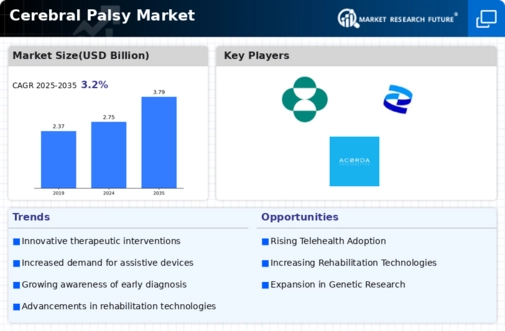Advancements in Medical Technology
Technological innovations play a crucial role in shaping the Cerebral Palsy Market. The development of advanced medical devices and therapeutic interventions has the potential to enhance the quality of life for individuals with cerebral palsy. For instance, the introduction of robotic-assisted therapy and neuromodulation techniques has shown promise in improving motor function and mobility. Additionally, telehealth services are becoming more prevalent, allowing for remote consultations and ongoing support for patients and families. These advancements not only improve treatment outcomes but also create new market opportunities for companies specializing in cerebral palsy solutions. As technology continues to evolve, the Cerebral Palsy Market is likely to witness a surge in demand for innovative products and services.
Rising Prevalence of Cerebral Palsy
The increasing prevalence of cerebral palsy is a notable driver in the Cerebral Palsy Market. Recent estimates suggest that approximately 1 in 345 children are diagnosed with cerebral palsy, indicating a growing population requiring specialized care and treatment. This rise in prevalence may be attributed to various factors, including improved diagnostic techniques and heightened awareness among healthcare professionals. As the number of diagnosed cases continues to grow, the demand for innovative therapies and assistive technologies is likely to expand, thereby propelling the Cerebral Palsy Market forward. Furthermore, the need for comprehensive care solutions, including physical therapy and rehabilitation services, is becoming increasingly apparent, which could lead to a more robust market landscape.
Legislative Support and Policy Changes
Legislative support and policy changes are emerging as significant drivers in the Cerebral Palsy Market. Governments are increasingly implementing policies aimed at improving access to care and resources for individuals with disabilities, including cerebral palsy. These initiatives often include funding for specialized programs, insurance coverage for therapies, and support for research initiatives. As policies evolve to better address the needs of this population, the market is likely to benefit from enhanced service availability and improved treatment options. Furthermore, advocacy groups are playing a pivotal role in pushing for legislative changes that promote inclusivity and accessibility, which could further stimulate growth within the Cerebral Palsy Market.
Growing Demand for Rehabilitation Services
The demand for rehabilitation services is steadily increasing within the Cerebral Palsy Market. As awareness of the importance of early intervention and ongoing support grows, families are seeking comprehensive rehabilitation programs that cater to the unique needs of individuals with cerebral palsy. This trend is reflected in the rising number of specialized clinics and therapy centers dedicated to providing tailored services. Additionally, the integration of multidisciplinary approaches, including occupational therapy, speech therapy, and physical therapy, is becoming more common. This holistic focus on rehabilitation not only enhances patient outcomes but also drives growth in the Cerebral Palsy Market, as more providers enter the market to meet the evolving needs of patients and their families.
Increased Funding for Research and Development
The Cerebral Palsy Market is experiencing a boost due to increased funding for research and development initiatives. Governments and private organizations are recognizing the need for more effective treatments and interventions for cerebral palsy. This influx of funding is facilitating clinical trials and the exploration of novel therapeutic approaches, such as gene therapy and stem cell research. As a result, the market is likely to see a rise in the availability of cutting-edge treatments that could significantly alter the management of cerebral palsy. Moreover, this financial support is fostering collaboration between academic institutions and industry players, which may lead to innovative solutions that address unmet needs within the Cerebral Palsy Market.


















Leave a Comment